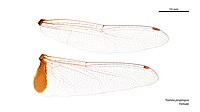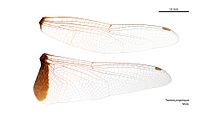
Orthetrum villosovittatum, known as the fiery skimmer, is a species of dragonfly in the family Libellulidae. Its range is from the Moluccas, New Guinea and neighbouring islands as well as Australia. In Australia it is found in Victoria through eastern New South Wales and Queensland, north inland Queensland, Cape York Peninsula and north Northern Territory. It is a common species through most of its range.

Orthetrum caledonicum, the blue skimmer, is a common Australian dragonfly in the family Libellulidae.

Brachydiplax is a genus of dragonflies in the family Libellulidae. They occur in Asia from India to China and Southeast Asia, and New Guinea to Australia.

Ischnura aurora, the gossamer damselfy or golden dartlet and also known as the aurora bluetail, is a species of damselfly in the family Coenagrionidae.

Anaciaeschna is a genus of dragonflies in the family Aeshnidae. Species of Anaciaeschna are found in Africa, Asia and Australia.
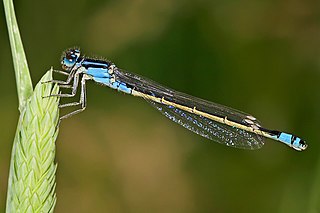
Ischnura is a genus of damselflies known as forktails in the family Coenagrionidae. Forktails are distributed worldwide, including various oceanic islands. The males have a forked projection at the tip of the abdomen which gives the group their common name.

Tramea is a genus of dragonflies in the family Libellulidae, the skimmers and perchers. Species of Tramea are found in tropical and subtropical regions around the globe. They typically have colored bases to their otherwise translucent hindwings. In particular when they fly, this creates the impression of their carrying bags at the start of their abdomens. They are known commonly as saddlebags or saddlebags gliders.

Agrionoptera is a genus of dragonflies in the family Libellulidae. Species of Agrionoptera are found across India, Southeast Asia and the Pacific.
Agyrtacantha is a genus of dragonflies in the family Aeshnidae. Species of Agyrtacantha can be large, dull-coloured dragonflies.
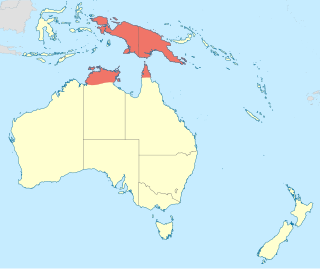
Orthetrum balteatum is a freshwater dragonfly species in the family Libellulidae, present in northern Australia and New Guinea. The common name for this species is speckled skimmer.

Orthetrum migratum is an Australian freshwater dragonfly species in the family Libellulidae. The common name for this species is rosy skimmer. It inhabits streams, boggy seepages, riverine pools and swamps across northern Australia.

Macrodiplax cora, the coastal glider, also known as wandering pennant, and Cora’s pennant, is a species of dragonfly in the family Libellulidae.

Nannodiplax rubra, commonly called the pygmy percher, is a species of dragonfly in the monotypic genus Nannodiplax. Its distribution seems to be limited to Australia and New Guinea. They are tiny dragonflies with a bright red abdomen and clear wings. They are found near a wide variety of rivers and streams. The Australian distribution ranges from Broome, Western Australia via the north and east to around Coffs Harbour, New South Wales. The taxon has not yet been assessed for the IUCN Red List, but it is listed in the Catalogue of Life.

Tramea loewii, the common glider, is a species of dragonfly in the Libellulidae family. It is found in the Cocos Islands, Moluccas, Lesser Sunda Islands, New Guinea, New Caledonia, Australia, and the western Pacific. Since 2005, Tramea loewii has also been recorded in New Zealand.

Diplacodes melanopsis is a species of dragonfly in the family Libellulidae known commonly as the blackfaced percher or black-faced percher. It occurs on the Australian mainland from around Brisbane to the South Australian-Victorian border.
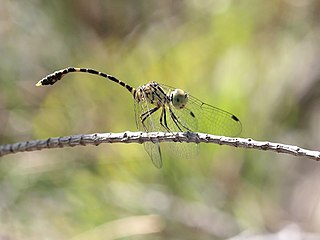
Nannophlebia risi, known as the common archtail, is a species of dragonfly in the family Libellulidae. It is endemic to Australia.
Huonia is a genus of dragonfly in the family Libellulidae. Species of this genus are found in Indonesia, New Guinea and Australia.

Notolibellula bicolor is a species of dragonfly in the family Libellulidae, known as the bicoloured skimmer. It is the only known species of Notolibellula. It is found across northern Australia where it inhabits rock-holes and still waters. It is a medium-sized dragonfly with the male having a bluish thorax and a red end to his abdomen.

Nannophya australis is a species of dragonfly of the family Libellulidae, known as the Australian pygmyfly. It inhabits boggy seepages and swamps in eastern Australia. It is a tiny dragonfly with black and red markings.

Neurothemis oligoneura is a species of dragonfly of the family Libellulidae, known as the spotted grasshawk. It is a medium-sized dragonfly with extensive darkening near the base of the wings found in northern Australia and New Guinea.




